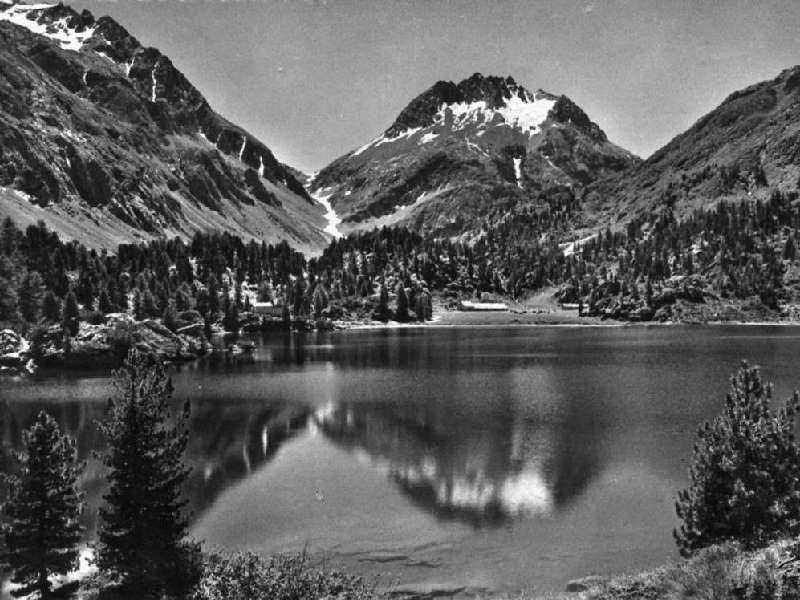Traffic along the Cavallera road became increasingly heavy, especially by the Bregalia traders, who were directly in charge of the Swiss side of the road.
The commercial and transport system at the time in Val Bregaglia also envisaged a series of measures for the so-called "Muretto route".
This was the right granted by contract to transport goods, usually wine, along the road of the Muretto pass.
The Muretto route was the wine route par excellence.
The contract for the "Muretto pass", also called the "Malenco route" was granted by appointing the 'rotter' [router], who would be granted the contract for the trade route for goods along the Muretto pass road.
His task was to 'open' the road to the Valmalenco, free it from snow and ice and keep it in good condition, at least for the stretch between the Maloja pass and the Malenco border.
 The Muretto valley seen from the Swiss side.
The Muretto valley seen from the Swiss side.
The numerous documents kept in the archive of Val Bregaglia Sopraporta in Vicosoprano have enabled us to rectify what had been believed until recently that the Municipality of Sondrio awarded a prize of a quantity of wine to the caravan guide who was the first to complete the return journey of the year along the Muretto pass raod.
In fact, the caravan guides, or rather the horse traders who left Sondrio with their horses laden with wine for the Val Bregaglia, were not originally from the Valmalenco or even from the Valtellina.
They were actually traders from Bregaglia, called "rotter" who had contracted the Muretto pass road.
To ensure the Muretto Pass road was also kept open on the Swiss side, the Community of Sondrio was probably forced to donate an additional horse, laden with wine, not to the rider from the Valtellina who was the first to pass the snow-covered Muretto road, but rather to the Bregaglia 'rotter', who had been awarded the contract and undertook to keep the Swiss side of the pass open to traffic and free from snow.
As you can imagine, both sides had a common interest in keeping the road open and free from any hazards.
The Cavallera road on the Malenco side had always been managed by a measure issued in 1549 by the Council of the Magnificent Valley of Malenco, the main administrative body in the Valley.
This divided the route into different segments, the maintenance of which was entrusted to the different districts and communities: Sondrio, Montagna and Spriana, Torre, the districts of Chiesa, Caspoggio and Lanzada and the innkeeper in Chiareggio.
Theinn in Chiareggio as a place for the traders to stay and rest with their horses must have existed at least since the beginning of the 16th century and it is easy to imagine how it must have been a mandatory stop half way along the route.
The archpriest of Sondrio, the blessed
Nicolò Rusca, also stopped at the inn during his forced journey to prison.
Lively trading along the Cavallera road flourished, despite the political and military events which determined the history of the Valley in the seventeenth century.
However, it had already began to show the first signs of decline in the second half of the eighteenth century, probably as a result of the increased volume of traffic on other, more easily asscessible, Rhaetian roads, such as the Bernina and the Spluga.
A decline, which became a veritable collapse from 1797 onwards, when first the Napoleonic and then the Austrian government replaced the Grigioni government.
From that moment onwards, the Grigioni of the three Leagues bcame a "dead corner" on the European political scene and the Muretto pass road saw a sudden interruption in the transit of trade, once the Grigioni traders saw they had lost their economic benefit in the Valtellina and hurried to turn elsewhere.
Nevertheless, numerous documents in the Muncipal Archive of Sondrio testify to the efforts of the valley communities and later of the provincial administration to keep trade alive along the road to the Muretto Pass.
From then owards, the Muretto pass road was abbandoned and became litle more than a well-trodden path, trod mainly by smugglers and shepherds from the Valmalenco who went to look for work in Engadine.
It was also used by the first tourists, the mountain enthusiasts who, between the nineteenth and twentieth centuries, went to discover the beauty of the Alpine valleys.
There has been a recent major intervention to recuperate and exploit the Cavallero road of the Muretto Pass, at least on the Italian side, from a tourism and cultural point of view, and it is now known as the
“Rusca Path”.